|
Scaphopod
Teleoconchs in the Fort Apache Limestone

Introduction
For over a decade,
this particular fossil gave us a lot of trouble when trying to
identify its affiliation. We had listed it as "problematica"
and until more fossils could be obtained, even its phylum was
in doubt. Recent collection of large amounts of material from
the Fort Apache Limestone at the Highway 260 site has enabled
us to nail down this obscure fossil. At first, we had considered
Tentaculitids or Cornulititids however the morphology wasn't
quite right, and the fact that they were extinct in the late
lower Permian made this untenable. I still felt strongly that
this still was some type of bizarre scaphopod, so I contacted
a well known Scaphopod expert at the Museum of Natural History
in Rotterdam in the Netherlands for help. Jordy van der Beek
(jordyvanderbeek.com) was glad to help us and so we sent him
more information and lots of photos of what we had. A few days
later, he responded and knew exactly what we had found. These
were the juvenile portion of a growing scaphopod known as a "Teleoconch".
They are seldom fossilized, however the unusual conditions in
the Fort Apache Sea greatly favors the preservation of very tiny
and juvenile mollusks. Here was something new and quite unexpected!
Now lets explain what a teleoconch is, and discuss its features.
So exactly what
is a "Teleoconch"?
Scaphopods have
three growth phases out of the egg. First, a protoconch is a
tiny ovoid shaped microscopic animal which swims in the plankton
and feeds on even smaller micro plankton. Then it settles down
to the bottom and starts to grow its cone shape. This phase,
called the "teleoconch" is curved, has slightly angled
transverse ribbing and is very small indeed - usually less than
half an inch. Finally, the little scaphopods "program"
changes and it switches to the adult phase. The transverse ribs
stop forming and are replaced with the smooth or linearly ribbed
adult exterior pattern. At some point, the teleoconch breaks
off and leaves the small end open to allow the current to flow
through the mollusk for its final configuration. And you can
find the the juveniles and discarded teleoconchs preserved in
the sediments as these small curved cone shaped fossils.
Explanation Diagrams
and photos
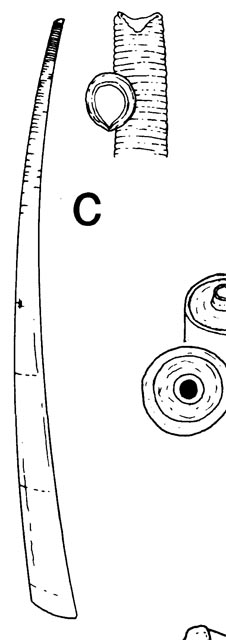
|
Adult scaphopod
at left here, at the top of the curving shell is the transversely
ribbed teleoconch region, which in most cases is lost when the
adults are full size. Not all scaphopods have such a distinct
teleoconch, some are smooth. Plagioglypta had the ribbing.
(Click to enlarge)
|
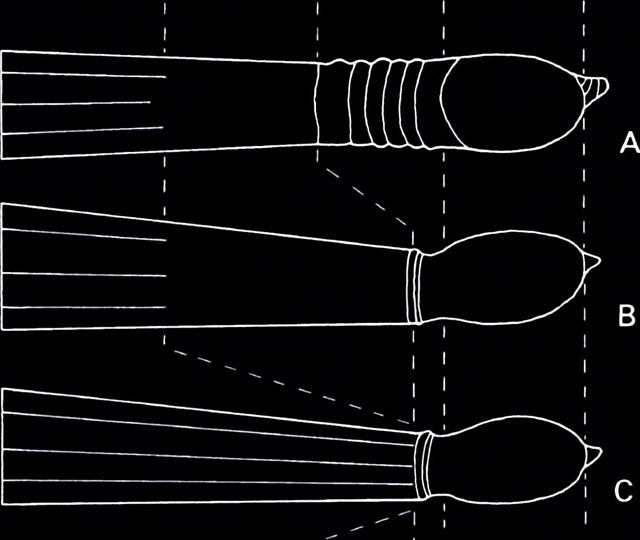
|
Protoconchs
on right and several phases of teleoconch seen here as it changes
to the adult phase on the left. (Steiner) |
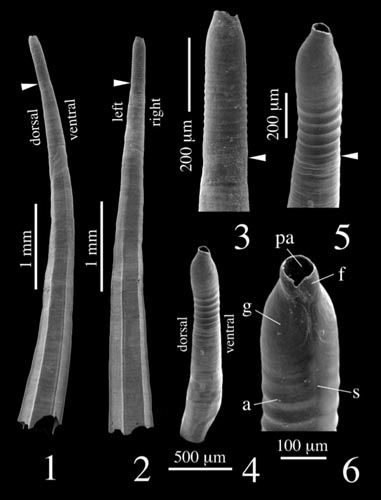
|
SEM
images of several teleoconchs of scaphopods. Clearly, there is
a rapid growth phase after the protoconch settles down followed
by the generation of transverse ribbing. (Steiner) |

|
SEM
images of extant scaphopods in their teleoconch phase. In reality,
these conchs are nearly as transparent as glass. (see below image) |
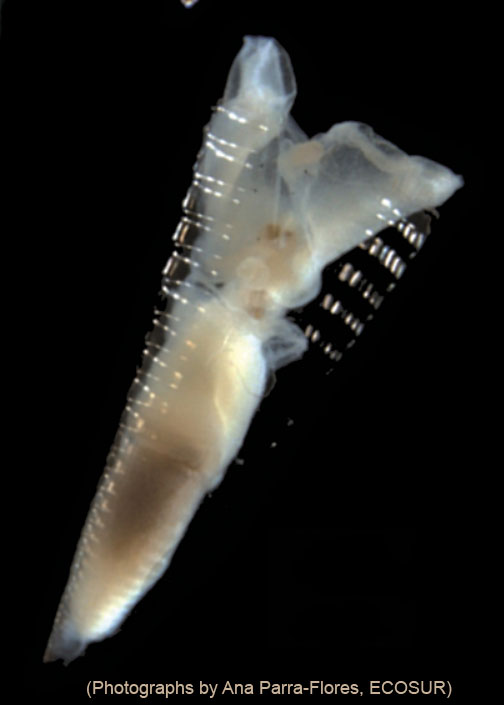
|
An
extant juvenile scaphopod living in the sea today, this teleoconch
is transparent and the internal animal can be seen clearly. Note
the transverse ribs on the exterior. |
Our recent Finds
Our techniques
for collection of fossil material is to first, collect limestones
that show a visible traces of internal silicified fossils on
their surfaces starting to dissolve out. Those will
always contain more within, and these are collected and packed
out on our backs for several miles back to the Jeep. Back
in our paleo lab, we dissolve the limestone in large plastic
tubs with a dilution of 10% muriatic acid obtained at ACE hardware
store in town. The next day, the acid fines are washed
and sorted with three or four different size sieves and dried
in flat Teflon coated metal pans in the sun. Sorting is
done one teaspoon at a time of the fines, under a stereo microscope.
Specimens are picked out with needle fine tweezers, or wet toothpicks.
The s found are
always less than half an inch in size, and most are broken fragments
of the tubes which contained the animal. However, a good
number of them were found complete and are stunning to see with
a good LED high intensity side light under the scope. They
are hollow, thin walled and are preserved as complete casts of
the original conch in a white amorphous silica. Their exterior
is covered with numerous transverse rings at a slight angle to
the conch, all touching with no space in between, however one
did show the transition to the adult smooth configuration.
Juvenile Scaphopod
Morphology
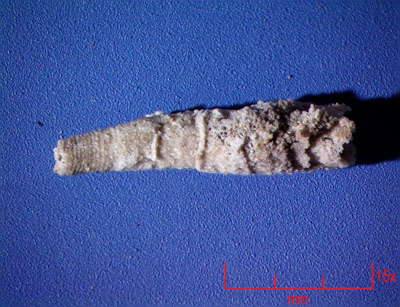
| Here
is one specimen which shows the transverse rings on the left
side in the teleoconch changing to the more smooth exterior shell
of the adult phase on the right. |
The Images
Photos of our specimens
were taken with an AmScope trinocular zoom microscope and an
AmScope 10 megapixel color CMOS camera. A dozen or more
images of each specimen were obtained with varied focus, and
the image sets were focus stacked with Picolay for the final
sharp image. Final touch up and the scale addition were
done in Adobe Photoshop. The magnification is listed on each
image next to the scale.

|
A
gaggle of a few of the more complete specimens. Most are less
than 1 cm long, and represent juveniles or early adults. 7x |
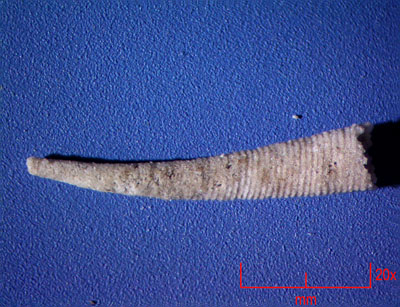
|
20x
close up of one of the more complete specimens. Some of the smallest
ribs are worn off on the left, but they continue in force on
the right. Note how the conch is curved and the transverse ribs
are skewed. |

|
45x
close up of the transverse rings morphology in the above specimen. |

|
Another
typical specimen at 20x. This one was actually flattened on the
left side. |

|
20x
third example. |
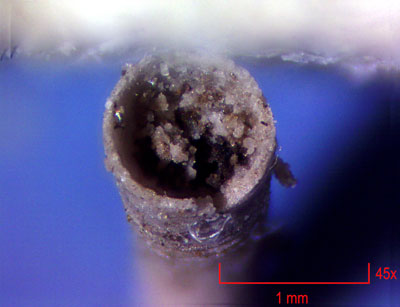
|
End
on view at 45x shows the wall thickness of an average sized specimen.
It is filled with sand and has no internal partitions. |
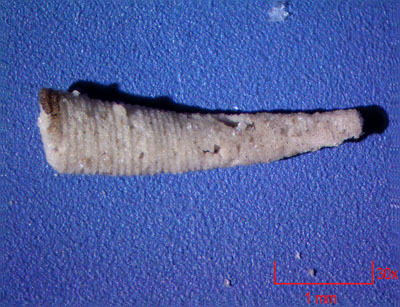
|
30x
view of the smallest mostly complete specimen we found. It is
really tiny! |
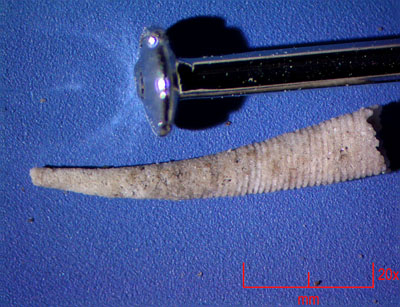
|
Compare
a pin head above to the average size we found at both sites. |
|
